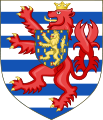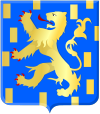Adolphe, Grand Duke of Luxembourg
| Adolphe | |
|---|---|
 | |
| Grand Duke of Luxembourg | |
| Reign | 23 November 1890 – 17 November 1905 |
| Predecessor | William III |
| Successor | William IV |
| Prime Minister | Paul Eyschen |
| Duke of Nassau | |
| Reign | 20 August 1839 – 20 September 1866 |
| Predecessor | William |
| Successor | Nassau annexed by the Kingdom of Prussia |
| Born | 24 July 1817 Biebrich Palace, Wiesbaden, Duchy of Nassau |
| Died | 17 November 1905 (aged 88) Schloss Hohenburg, Lenggries, Kingdom of Bavaria, German Empire |
| Burial | Schlosskirche of Schloss Weilburg (since 1953) |
| Spouse | |
| Issue Among others | William IV, Grand Duke of Luxembourg Hilda, Grand Duchess of Baden |
| House | Nassau-Weilburg |
| Father | Wilhelm, Duke of Nassau |
| Mother | Princess Louise of Saxe-Hildburghausen |
| Religion | Protestantism |
| Signature | |
Adolphe (Adolf Wilhelm August Karl Friedrich; 24 July 1817 – 17 November 1905) was Grand Duke of Luxembourg from 23 November 1890 to his death on 17 November 1905. The first grand duke from the House of Nassau-Weilburg, he succeeded King William III of the Netherlands, ending the personal union between the Netherlands and Luxembourg. Adolphe was Duke of Nassau from 20 August 1839 to 20 September 1866, when the Duchy was annexed to the Kingdom of Prussia.
Adolphe became Duke of Nassau in August 1839, following the death of his father William. The Duchy was annexed to Prussia after Austria's defeat in the Austro-Prussian War. From 1815 to 1839, the Grand Duchy of Luxembourg was ruled by the kings of the Netherlands as a province of the Netherlands. Following the Treaty of London (1839), the Grand Duchy became independent but remained in personal union with the Netherlands. Following the death of his sons, the Dutch king William III had no male heirs to succeed him. In the Netherlands, females were allowed to succeed to the throne. Luxembourg, however, followed Salic law which barred females from succession. Thus, upon King William III's death, the crown of the Netherlands passed to his only daughter, Wilhelmina, while that of Luxembourg passed to Adolphe in accordance with the Nassau Family Pact. Adolphe died in 1905 and was succeeded by his son, William IV.
Biography
[edit]He was a son of William, Duke of Nassau (1792–1839), and his first wife, Princess Louise of Saxe-Hildburghausen. Adolphe's half-sister, Sophia of Nassau, was the wife of Oscar II of Sweden.
Duke of Nassau
[edit]
Adolphe became Duke of Nassau in August 1839 at the age of 22, after the death of his father. Wiesbaden had by this time become the capital of the Duchy, and Adolphe took up residence in the newly constructed Stadtschloss in 1841. On 4 March 1848 he consented to the population of Nassau's nine "Demands of the Nassauers". A few years later, however, he revoked his liberal views and took a strongly conservative and reactionary course. In general, though, he was seen as a popular ruler. He supported the Austrian Empire in the Austro-Prussian War of 1866. After Austria's defeat, Nassau was annexed to the Kingdom of Prussia and he lost his throne on 20 September 1866.
Grand Duke of Luxembourg
[edit]In 1879, Adolphe's niece Emma of Waldeck and Pyrmont, the daughter of another of his half-sisters, married William III, King of the Netherlands and Grand Duke of Luxembourg. In 1890, upon William's death without surviving male issue, their only daughter Wilhelmina succeeded to the Dutch throne, but was excluded from the succession to Luxembourg by Salic law. The Grand Duchy, which had been linked to the Netherlands in personal union since 1815, passed to Adolphe in accordance with the Nassau Family Pact. Adolphe was King-Grand Duke William III's 17th cousin once removed through a male-only line, but was also his 3rd cousin as they both descended from William IV, Prince of Orange (he being the paternal great-grandson of William IV's eldest daughter Princess Carolina of Orange-Nassau). He had, in fact, taken over the regency of Luxembourg for a short time during William III's illness.
Adolphe was already 73 years old by this time and knew little of Luxembourgish politics. He mostly abstained from day-to-day governing; Prime Minister Paul Eyschen, in office since 1888, took care of the affairs of state. This established a convention that the monarch would remain absent from the politics of the day, despite being vested with considerable reserve powers on paper. In 1902 Adolphe appointed his son William as Lieutenant-Representative. He died in 1905 at his summer home, Schloss Hohenburg in Lenggries, and in 1953 was buried in the crypt of the church of Schloss Weilburg.
Personal life
[edit]On 31 January 1844, Adolphe married firstly in St. Petersburg Grand Duchess Elizabeth Mikhailovna of Russia, niece of Emperor Nicholas I of Russia. She died less than a year afterwards giving birth to a stillborn daughter. Adolphe built the Russian Orthodox Church of Saint Elizabeth 1847 to 1855 as her funeral church.
On 23 April 1851, he remarried in Princess Adelheid-Marie of Anhalt-Dessau. They had five children, of whom only two lived to the age of eighteen and became prince and princess of Luxembourg:
- William IV, Grand Duke of Luxembourg (1852–1912)
- Prince Friedrich Paul Wilhelm of Nassau (Biebrich, 23 September 1854 – Biebrich, 23 October 1855)
- Princess Marie Bathildis Wilhelmine Charlotte of Nassau (Biebrich, 14 November 1857 – Biebrich, 28 December 1857)[1]
- Prince Franz Joseph Wilhelm of Nassau (Biebrich, 30 January 1859 – Vienna, 2 April 1875)
- Princess Hilda Charlotte Wilhelmine (1864–1952), married Friedrich II, Grand Duke of Baden.
In 1892, Grand Duke Adolphe conferred the personal title of Prince Bernadotte in the nobility of Luxembourg as well as the hereditary title of Count of Wisborg[2] on his Swedish nephew, Oscar, who had lost his Swedish titles after marrying without his father's approval. Wisborg (also spelled Visborg) is the ruins of an old castle in the city of Visby within Oscar's former Dukedom of Gotland, but the title itself was created in the nobility of Luxembourg.
Adelsverein
[edit]On April 20, 1842, the Adelsverein, Society for the Protection of German Immigrants in Texas, was organised in the Grand Duke's castle at Biebrich on the Rhine. He was named the Protector of the organisation. The Verein was responsible for the large emigration of Germans to Texas in the 19th century, and on January 9, 1843, established the 4,428 acre Nassau Plantation in Fayette County, Texas and named it after the Grand Duke.[3][4]
Honours
[edit] Russian Empire: Knight of St. Andrew, 20 September 1839
Russian Empire: Knight of St. Andrew, 20 September 1839

 Ernestine duchies: Grand Cross of the Saxe-Ernestine House Order, October 1839[5]
Ernestine duchies: Grand Cross of the Saxe-Ernestine House Order, October 1839[5] Baden:[6]
Baden:[6]
- Knight of the House Order of Fidelity, 1839
- Grand Cross of the Zähringer Lion, 1839
 Kingdom of Bavaria: Knight of St. Hubert, 1839[7]
Kingdom of Bavaria: Knight of St. Hubert, 1839[7] Kingdom of Hanover:[8]
Kingdom of Hanover:[8]
 Denmark: Knight of the Elephant, 1 February 1840[9]
Denmark: Knight of the Elephant, 1 February 1840[9] Kingdom of Prussia: Knight of the Black Eagle, 12 March 1840[10]
Kingdom of Prussia: Knight of the Black Eagle, 12 March 1840[10] Austrian Empire: Grand Cross of St. Stephen, 1840[11]
Austrian Empire: Grand Cross of St. Stephen, 1840[11] Grand Duchy of Hesse: Grand Cross of the Ludwig Order, 8 January 1843[12]
Grand Duchy of Hesse: Grand Cross of the Ludwig Order, 8 January 1843[12] Saxe-Weimar-Eisenach: Grand Cross of the White Falcon, 1 November 1843[13]
Saxe-Weimar-Eisenach: Grand Cross of the White Falcon, 1 November 1843[13] Württemberg: Grand Cross of the Württemberg Crown, 1846[14]
Württemberg: Grand Cross of the Württemberg Crown, 1846[14] Oldenburg: Grand Cross of the Order of Duke Peter Friedrich Ludwig, with Golden Crown, 9 September 1849[15]
Oldenburg: Grand Cross of the Order of Duke Peter Friedrich Ludwig, with Golden Crown, 9 September 1849[15] Electorate of Hesse: Grand Cross of the Golden Lion, 16 July 1850[16]
Electorate of Hesse: Grand Cross of the Golden Lion, 16 July 1850[16] Ascanian duchies: Grand Cross of Albert the Bear, 12 February 1851[17]
Ascanian duchies: Grand Cross of Albert the Bear, 12 February 1851[17]
 Sweden-Norway:
Sweden-Norway:
- Knight of the Seraphim, 10 October 1856[18]
- Grand Cross of St. Olav, 12 July 1858[19]
 Kingdom of Saxony: Knight of the Rue Crown, 1857[20]
Kingdom of Saxony: Knight of the Rue Crown, 1857[20] Nassau:[21]
Nassau:[21]
- Joint Grand Master of the Order of the Gold Lion of Nassau, 16 March 1858
- Founder and Grand Master of the Order of Adolphe of Nassau, 8 May 1858
 Belgium: Grand Cordon of the Order of Leopold, 10 August 1861[22]
Belgium: Grand Cordon of the Order of Leopold, 10 August 1861[22] Luxembourg: Grand Master of the Order of the Oak Crown, 23 November 1890
Luxembourg: Grand Master of the Order of the Oak Crown, 23 November 1890
Arms
[edit]-
Coat of arms of Adolphe, 1890 - 1898
-
Coat of arms of Adolphe and Grand Duke of Luxembourg in general, 1898 - 2000
Ancestry
[edit]| Ancestors of Adolphe, Grand Duke of Luxembourg | |||||||||||||||||||||||||||||||||||||||||||||||||||||||||||||||||||||||||||||||||||||||||||||||||||||||||||||||||||||||||||||||||||||||||||||||||||||||||||||||||||||||||||||||||||||||||||||||||||||||||||||||||||||||||||||||||||||||||||||||||||||||||||||||||||||||||||||||||||||||||
|---|---|---|---|---|---|---|---|---|---|---|---|---|---|---|---|---|---|---|---|---|---|---|---|---|---|---|---|---|---|---|---|---|---|---|---|---|---|---|---|---|---|---|---|---|---|---|---|---|---|---|---|---|---|---|---|---|---|---|---|---|---|---|---|---|---|---|---|---|---|---|---|---|---|---|---|---|---|---|---|---|---|---|---|---|---|---|---|---|---|---|---|---|---|---|---|---|---|---|---|---|---|---|---|---|---|---|---|---|---|---|---|---|---|---|---|---|---|---|---|---|---|---|---|---|---|---|---|---|---|---|---|---|---|---|---|---|---|---|---|---|---|---|---|---|---|---|---|---|---|---|---|---|---|---|---|---|---|---|---|---|---|---|---|---|---|---|---|---|---|---|---|---|---|---|---|---|---|---|---|---|---|---|---|---|---|---|---|---|---|---|---|---|---|---|---|---|---|---|---|---|---|---|---|---|---|---|---|---|---|---|---|---|---|---|---|---|---|---|---|---|---|---|---|---|---|---|---|---|---|---|---|---|---|---|---|---|---|---|---|---|---|---|---|---|---|---|---|---|---|---|---|---|---|---|---|---|---|---|---|---|---|---|---|---|---|---|---|---|---|---|---|---|---|---|---|---|---|---|---|---|---|
| |||||||||||||||||||||||||||||||||||||||||||||||||||||||||||||||||||||||||||||||||||||||||||||||||||||||||||||||||||||||||||||||||||||||||||||||||||||||||||||||||||||||||||||||||||||||||||||||||||||||||||||||||||||||||||||||||||||||||||||||||||||||||||||||||||||||||||||||||||||||||
References
[edit]- ^ "Full name". Archived from the original on 2014-07-17. Retrieved 2014-01-17.
- ^ Roger Lundgren in Sibylla en biografi Bonniers Stockholm ISBN 9789100111120 p. 62, specifically naming both the noble titles as created then
- ^ King, Irene Marschall (1967). John O.Meusebach. University of Texas Press. p. 33. ISBN 978-0-292-73656-6.
- ^ Garrett, Daphne Dalton. "Nassau Farm". Handbook of Texas Online. Texas State Historical Association. Archived from the original on 30 November 2010. Retrieved 29 December 2010.
- ^ Staatshandbücher für das Herzogtum Sachsen-Coburg und Gotha (1843), "Herzogliche Sachsen-Ernestinischer Hausorden" p. 6
- ^ Hof- und Staats-Handbuch des Großherzogtum Baden (1841), "Großherzogliche Orden" pp. 29, 44
- ^ Hof- und Staats-Handbuch des Königreichs Bayern (in German). Königl. Oberpostamt. 1867. p. 8. Retrieved 2019-07-15.
- ^ Staat Hannover (1861). Hof- und Staatshandbuch für das Königreich Hannover: 1861. Berenberg. pp. 37, 70.
- ^ Jørgen Pedersen (2009). Riddere af Elefantordenen, 1559–2009 (in Danish). Syddansk Universitetsforlag. p. 466. ISBN 978-87-7674-434-2.
- ^ Liste der Ritter des Königlich Preußischen Hohen Ordens vom Schwarzen Adler (1851), "Von Seiner Majestät dem Könige Friedrich Wilhelm III. ernannte Ritter" p. 21
- ^ "A Szent István Rend tagjai" Archived 22 December 2010 at the Wayback Machine
- ^ Hof- und Staats-Handbuch des Großherzogtum Hessen (1879), "Großherzogliche Orden und Ehrenzeichen" p. 10
- ^ Staatshandbuch für das Großherzogtum Sachsen / Sachsen-Weimar-Eisenach (1846), "Großherzogliche Hausorden" p. 9
- ^ Hof- und Staats-Handbuch des Königreich Württemberg (1907), "Königliche Orden" p. 27
- ^ Hof- und Staatshandbuch des Großherzogtums Oldenburg: für das Jahr 1872/73, "Der Großherzogliche Haus-und Verdienst Orden" p. 30
- ^ Hof- und Staats-Handbuch des Großherzogtum Hessen (1879), "Großherzogliche Orden und Ehrenzeichen" p. 44
- ^ Hof- und Staats-Handbuch für des Herzogtum Anhalt (1867), "Herzoglicher Haus-Orden Albrecht des Bären" p. 17
- ^ Sveriges och Norges statskalender. Liberförlag. 1874. p. 468.
- ^ Norges Statskalender (in Norwegian), 1890, pp. 593–594, retrieved 2018-01-06 – via runeberg.org
- ^ Sachsen (1866). Staatshandbuch für den Freistaat Sachsen: 1865/66. Heinrich. p. 4.
- ^ Staats- und Adreß-Handbuch des Herzogthums Nassau: 1859. Schellenberg. 1859. pp. 7, 9.
- ^ "Liste des Membres de l'Ordre de Léopold", Almanach Royal Officiel (in French), 1863, p. 51 – via Archives de Bruxelles
External links
[edit]- 1817 births
- 1905 deaths
- 19th-century regents
- People from Wiesbaden
- People from the Duchy of Nassau
- Dukes of Nassau
- Grand dukes of Luxembourg
- House of Nassau-Weilburg
- Protestant monarchs
- Luxembourgian Protestants
- Burials in the Royal Crypt of Weilburg Schlosskirche
- Generals of Cavalry (Prussia)
- 19th-century Luxembourgian people
- Grand Crosses of the Order of Saint Stephen of Hungary
- Royal reburials
- Sons of dukes






